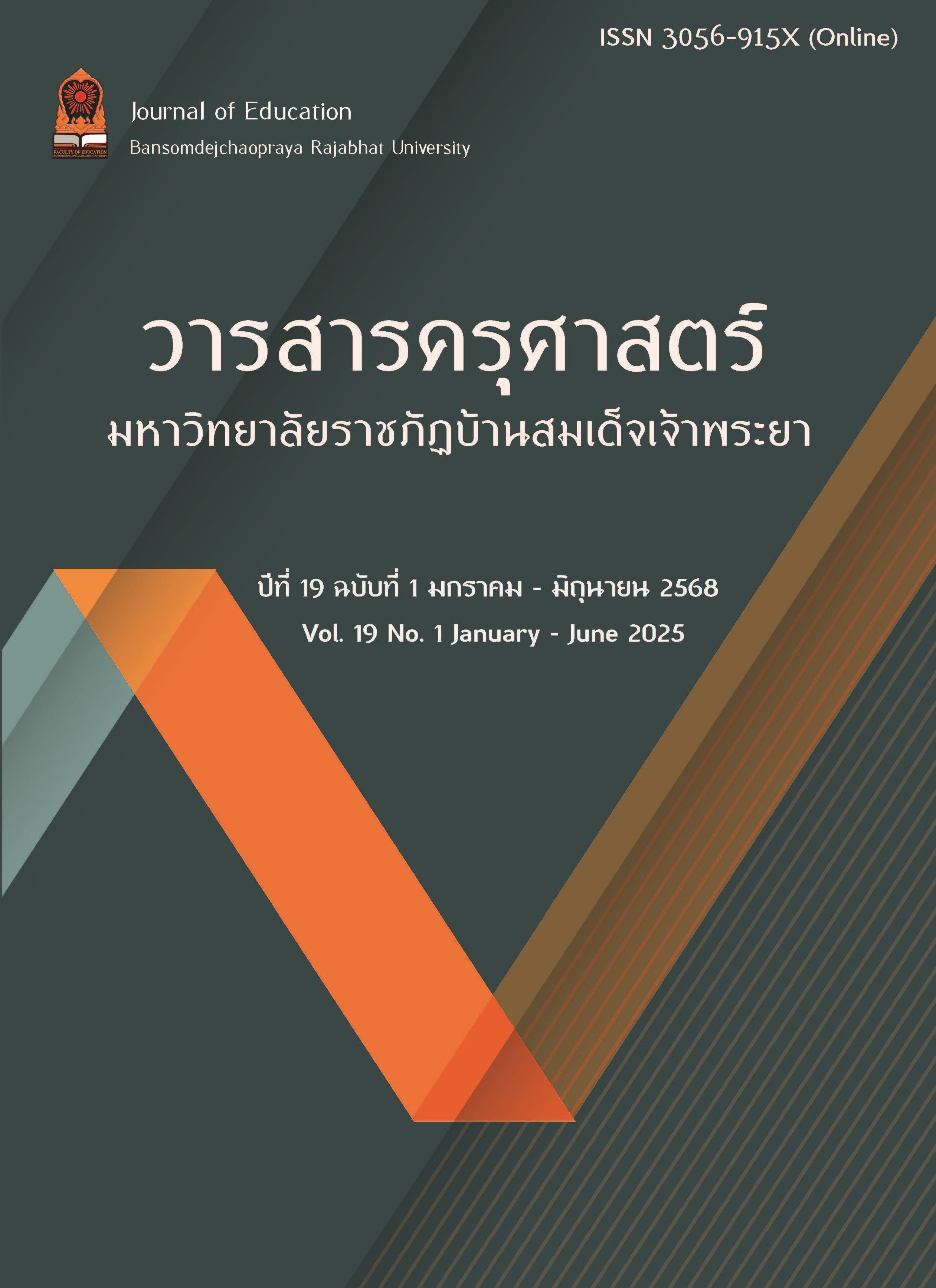The development of creative thinking by Applying Torrance's Learning Management Theory Integrated with the open Approach in the Economics subject for Grade 7
Keywords:
develop creativity, torrance's theory of creativity, open approach teaching methodAbstract
The objectives of this research are: 1) To develop creative thinking by applying Torrance's learning management process combined with the concept of open-ended teaching. 2) To examine the opinions of Grade 7 students at Satri Wat Rakhang School regarding the approach of Torrance’s learning management Theory with open-ended teaching. The sample group consisted of 40 Grade 7/4 students from Satri Wat Rakhang School, selected through purposive sampling. The research instruments included: 1) A lesson plan on Fundamental Economic Problems., 2) A self-assessment creativity evaluation for Grade 7 students, 3) A product-based creativity assessment for Grade 7 students and 4) A questionnaire on students' opinions regarding the teacher's teaching methods. The statistics used for data analysis include the mean and standard deviation.
The study found that :
1. The development of creative thinking through the application of Torrance's learning management process combined with the open-ended instructional approach showed that the comparison of creative thinking scores—categorized by different aspects—based on students’ self-assessment before and after the learning process indicated an improvement. The post-learning average score (x̄ = 51.85, S.D. = 0.75) was higher than the pre-learning average score ( x̄ = 35.28, S.D. = 1.33)
2. Regarding students’ opinions toward the instruction using Torrance’s learning management process integrated with the open-ended teaching approach, it was found that Grade 7 students at Satri Wat Rakhang School expressed positive opinions toward the teacher, the learning activities, the instructional media, and the classroom atmosphere
Downloads
References
ขวัญสกุล อุปพันธ์. (2564). การพัฒนาความคิดสร้างสรรค์โดยใช้รูปแบบการเรียนการสอนกระบวนการคิด แก้ปัญหาอนาคตตามแนวคิดของทอร์แรนซ์ รายวิชาบูรณาการความรู้ โรงเรียนมหิดลวิทยานุสรณ์ (รายงานการวิจัย). นครปฐม: โรงเรียนมหิดลวิทยานุสรณ์องค์การมหาชน.
จินดา ลาโพธิ์. (2563). พฤติกรรมการสอนของครูกับการเรียนรู้ของผู้เรียน. วารสารมหาจุฬานาครทรรศน์, 7(5), 36-45.
จิรัฐติพร ชูเมือง และสังเวียน ปินะกาลัง. (2564). การพัฒนาความสามารถด้านการคิดสร้างสรรค์ ในชั้นเรียนภาษาไทยด้วยการจัดการเรียนรู้แบบเปิด. วารสารบัณฑิตศึกษามหาจุฬาขอนแก่น, 8(3), 249-258.
ณัฐกานต์ ภูมิคอนสาร. (2565). ทักษะความคิดสร้างสรรค์ที่หล่นหายไปของผู้เรียนกับการศึกษาในศตวรรษที่ 21. วารสารการศึกษาคณะครุศาสตร์ มหาวิทยาลัยราชภัฏนครสวรรค์, 5(1), 1-9.
โนรอัซมา อดลุศรีศิลป์, รัชดา เชาวน์เสฏฐกุล และอดิศร ศิริ. (2566). การจัดการเรียนรู้แบบเปิดที่ส่งเสริมสมรรถนะการแปลความหมายข้อมูลและการใช้ ประจักษ์พยานเชิงวิทยาศาสตร์และความพึงใจของนักเรียนชั้นประถมศึกษาปีที่ 5 ใน รายวิชาวิทยาศาสตร์. วารสาร AL-NUR บัณฑิตวิทยาลัย, 18(34), 129-143.
บุหลัน บุษบานนท์. (2562). การใช้สื่อเทคโนโลยีการศึกษาในการจัดการเรียนการสอนของครู สังกัดสำนักงานคณะกรรมการการอาชีวศึกษา จังหวัดอุทัยธานี (รายงานวิจัย). นนทบุรี: มหาวิทยาลัยสุโขทัยธรรมาธิราช.
ปราณี พงษ์สุพรรณ, ไพฑูรย์ สินลารัตน์ และศศิธร เขียวกอ. (2562). การพัฒนาหลักสูตรเสริมสะเต็มศึกษาเพื่อส่งเสริมความคิดสร้างสรรค์และความคิดผลิตภาพ สำหรับนักเรียนประถมศึกษาปีที่ 4. วารสารครุศาสตร์ จุฬาลงกรณ์มหาวิทยาลัย, 47(1), 219-239.
ปานทิพย์ พอดี. (2564). รูปแบบการเรียนรู้อย่างมีความสุข (FART). วารสารวิชาการสังคมมนุษย์ มหาวิทยาลัยราชภัฏนครศรีธรรมราช, 11(1), 78-90.
ปาริฉัตร ศรีพล. (2563). การจัดการเรียนรู้โดยใช้ปัญหาเป็นฐานที่มีผลสัมฤทธิ์ทางการเรียนวิชาเศรษฐศาสตร์ของนักเรียนชั้นประถมศึกษาปีที่ 5. (วิทยานิพนธ์ครุศาสตรหาบัณฑิต). นครสวรรค์: มหาวิทยาลัยราชภัฏนครสวรรค์.
พระสิทธิชัย รินฤทธิ์ และสุรีพร ชาบุตรบุณฑริก. (2563). การจัดการเรียนการสอนสังคมศึกษาในศตวรรษที่ 21. วารสารวิชาการ มหาวิทยาลัยมหามกุฏราชวิทยาลัย, 5(2), 205-212.
ฤทัยทิพย์ โสภา. (2567). การพัฒนาการจัดการเรียนรู้วิชาพลศึกษาตามแนวคิดของทอร์แรนซ์ที่มีต่อความฉลาดทางการเล่นของนักเรียนประถมศึกษาปีที่ 6. วารสารสถาบันวิจัยและพัฒนา มหาวิทยาลัยราชภัฏชัยภูมิ, 6(2), 386-399.
วิชาออกแบบและเทคโนโลยี สสวท. (2561). ความคิดสร้างสรรค์ (แบ่งเป็น 4 ลักษณะ). เข้าถึงได้จาก. http://designtechnology.ipst.ac.th/wpcontent/uploads/sites/83 /2019/01.
ศิญาพร ชมพู่ และธรากร จันทนะสาโร. (2566). การพัฒนากิจกรรมตามแนวคิดโมทีฟโนเทชั่น เพื่อพัฒนาความคิดสร้างสรรค์ของ นักเรียนระดับชั้นมัธยมศึกษาตอนต้น. วารสารบัณฑิตวิทยาลัย มหาวิทยาลัยราชภัฏจันทรเกษม, 18(1), 94-108.
สุธีรา งามเกียรติทรัพย์. (2564). การสร้างบรรยากาศในการเรียนให้เกิดความคิดสร้างสรรค์. วารสารนิตยสารเสียงธรรมจากมหายาน, 7(1), 23-33.
สุพัตรา บุญทิสา. (2565). การพัฒนากิจกรรมการเรียนรู้แบบสร้างสรรค์เป็นฐานร่วมกับสื่อสังคมออนไลน์เรื่อง เศรษฐศาสตร์ เพื่อส่งเสริมความคิดสร้างสรรค์ ของนักเรียนชั้นประถมศึกษาปีที่ 5. (วิทยานิพนธ์การศึกษามหาบัณฑิต). มหาสารคาม: มหาวิทยาลัยมหาสารคาม.
Downloads
Published
How to Cite
Issue
Section
License
Copyright (c) 2025 Faculty of Educaion Bansomdejchaopraya Rajabhat University

This work is licensed under a Creative Commons Attribution-NonCommercial-NoDerivatives 4.0 International License.
บทความที่ได้รับการตีพิมพ์เป็นลิขสิทธิ์ของคณะครุศาสตร์ มหาวิทยาลัยราชภัฏบ้านสมเด็จเจ้าพระยา
ข้อความที่ปรากฏในบทความแต่ละเรื่องในวารสารวิชาการเล่มนี้เป็นความคิดเห็นส่วนตัวของผู้เขียนแต่ละท่านไม่เกี่ยวข้องกับมหาวิทยาลัยราชภัฏบ้านสมเด็จเจ้าพระยา และคณาจารย์ท่านอื่นๆในมหาวิทยาลัยฯ แต่อย่างใด ความรับผิดชอบองค์ประกอบทั้งหมดของบทความแต่ละเรื่องเป็นของผู้เขียนแต่ละท่าน หากมีความผิดพลาดใดๆ ผู้เขียนแต่ละท่านจะรับผิดชอบบทความของตนเอง



